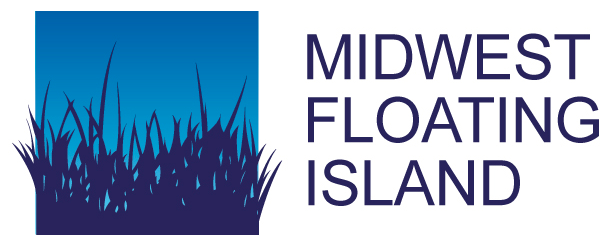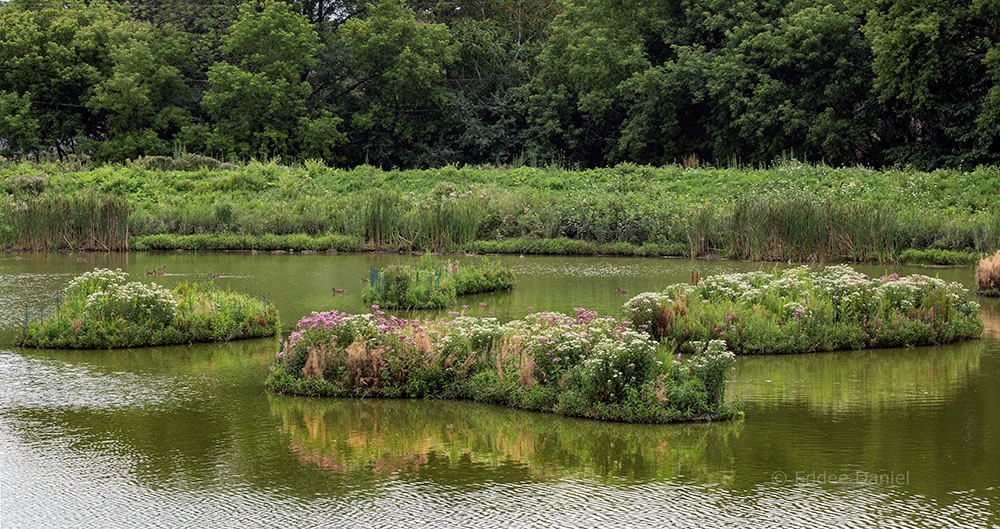FAQs for a Floating Island
1. What is a BioHaven® floating island?
BioHaven® floating islands are a green technology that “biomimics” natural floating wetlands to clean the water and provide habitat in a variety of ponds, lakes, and other waterbodies. These islands are an innovative, floating version of a constructed wetland that can be positioned in places where you could not install a traditional constructed wetland due to constraints such as cost, lack of space, and ease of access.
Islands quickly create a diverse floating ecosystem. Plants flourish due to the greater access to sunlight than on the shore and the ability to float which allows the roots to have a constant supply of water. The island will quickly attract small aquatic life forms, butterflies, dragonflies, birds, turtles, frogs, ducks, and fish.
2. How does a BioHaven® floating wetland improve water quality?
Many bodies of water associated in the Midwest and Northeast carry an unnaturally high nutrient load. This can result in algae growth and a wide range of serious water quality problems. BioHavens® represent a holistic way to reduce those nutrients and convert them into floating island habitat.
BioHaven® constructed wetland islands are a type of floating bioreactor designed to improve water quality by leveraging biofilm and microbial activity on the long plant roots and in and below the island material. Independent research has proven the efficacy of BioHaven® in reducing nitrates, phosphorus, ammonia, total suspended solids (TSS), biochemical oxygen demand (BOD), heavy metals and coliform. Studies have also shown that the islands will reduce heavy metals and improve the dissolved oxygen (DO) levels that promote healthy aquatic life.
3. What it the material used for a BioHaven® island?
Floating islands are a proprietary product designed to be safe in the water. The matrix material which forms the substrate is made from recycled PET from pop and water bottles that does not use BPA. This material is used because it is an ideal substance for growing the sticky biofil which attracts the microbes for removing contaminants. The matrix material was used safely in water many years before BioHavens® were invented and has been tested to be safe for fish.
We use a marine-safe material to add the buoyancy.
4. What will grow on a BioHaven® floating island?
We recommend native plants that like water, but many people add in annuals for color. Many nurseries have wetland plants available. Click here for a list of some examples of wetland plants popular in the Midwest but we recommend you choose plants appropriate for your planting zone.
5. How do you decide the size for a floating treatment wetland to reduce contaminants?
We can guide you on the size of your island based on the size of the waterbody, the current water quality information, your goals, and your budget. The islands will remove more pollutants if they are bigger (so more surface area for the microbes) and if there is water circulated past the island.
6. Is it important or useful to anchor my BioHaven® in one spot? If so, how are they anchored?
We recommend anchoring your island so it can go up and down with changing water levels. A disadvantage of leaving your BioHaven® unanchored is that if your pond’s water level changes, your island may hang up against a shoreline.
All islands come with anchor attachment points through which an anchor “rope,” chain, or stainless steel cable can be inserted. A heavy object can then be tied to the other end and lowered to bottom. Be sure to allow enough slack for fluctuations in the water level after storms. Alternatively you can tether your island to the shore, which has some advantages in making it accessible. To learn more about island maintenance and anchoring, click here.
7. How long will it take for my BioHaven® to mature into a beautiful floating island?
No more than one season. In fact, many experienced gardeners report that their islands develop faster than conventional gardens.
8. Do BioHavens® attract mosquitoes?
No, just the opposite – the islands attract fish, nymphs, and other insects that actually consume mosquito larvae. The plants provide a great habitat for damsel and dragon flies. They are remarkable mosquito predators.
9. Will a BioHaven® plug up?
We have not had issues with islands plugging up. Even if the island is accumulating solids and biofilm inside the matrix, it is constantly being “eaten” by fish and other small (or large) life forms. The heavier stuff will tend to slough off into the sediment below. This is unlike a constructed wetland, which will tend to plug up in due course.
10. When can I plant my BioHaven® Floating Island if I live in the northern US?
People in the North successfully plant new islands between early May and late September. The plants will come back the next spring just like natural wetlands.
11. Can I use a floating island as swimming platform?
No, please do not swim around or underneath a BioHaven® floating island. Our floating islands are designed to quickly become a floating eco-system that bio-mimics natural wetlands. The root growth below the islands and anchors could represent a swimming or diving hazard.
12. What is the minimum water depth?
We recommend you place the islands in at least 3 feet of water so the plants do not root into the bottom. Islands will remove more contaminants if the roots remain free-floating.
13. What Maintenance is required?
Like your garden, BioHaven® Islands will need some maintenance to remove invasive species. We recommend checking your anchoring after strong storms. Please read our blog on maintenance.
14. Should I have a 20′ x 20′ island or several smaller islands for the same square footage?
Multiple 10 feet long islands are easier to launch and maintain than one huge island.
15. Can I leave the floating mats in ponds over the winter?
Floating islands do not need to be removed from ponds. For lakes, you should consider if you would leave a floating dock in that location over the winter.
16. Where are the islands made?
All BioHaven® products are made in the US.

